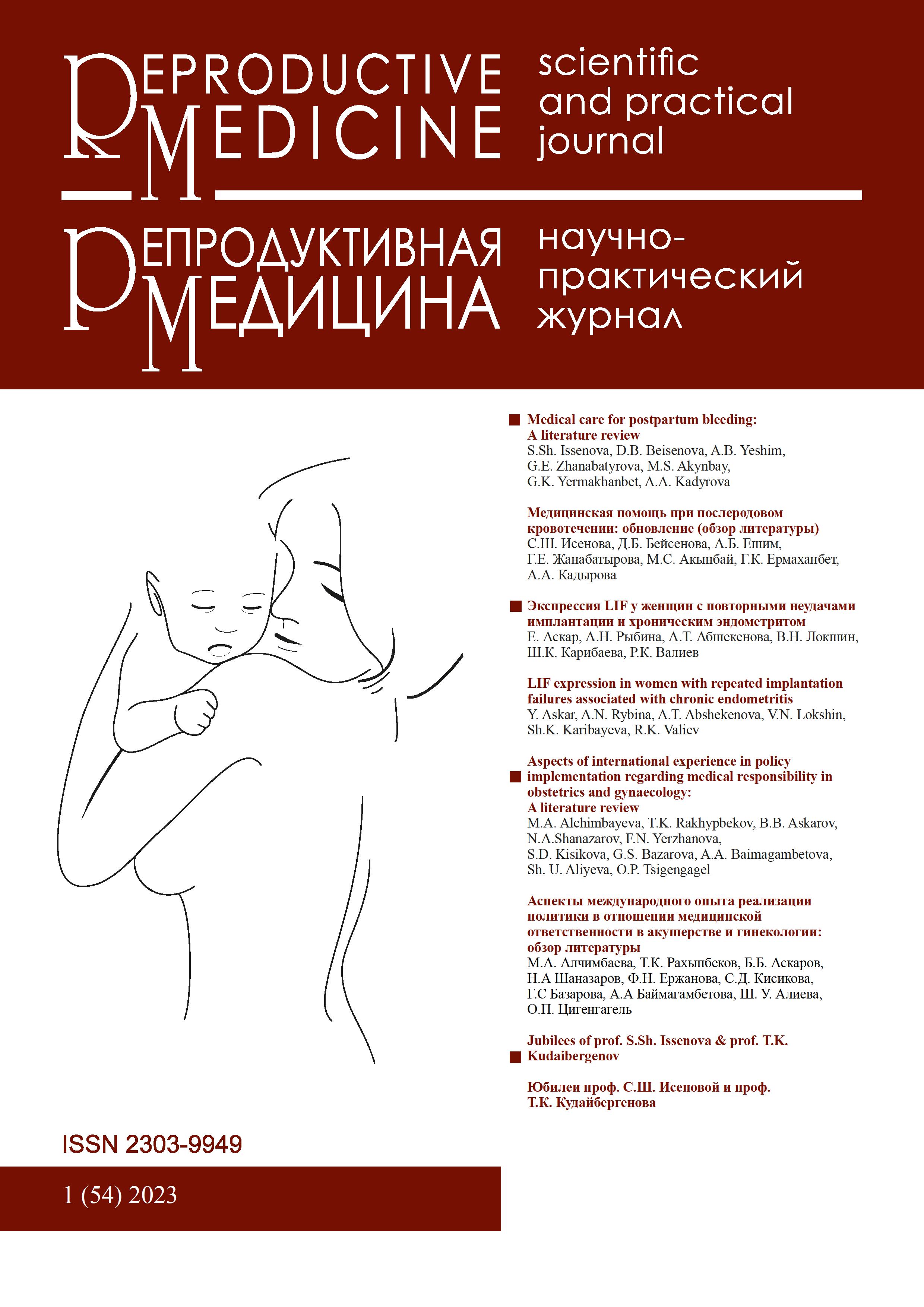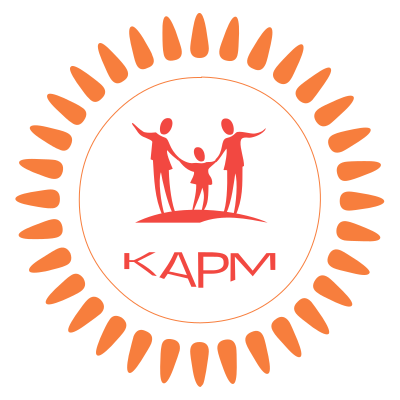Abdominal delivery in a perinatal center
DOI:
https://doi.org/10.37800/RM.1.2023.57-70Keywords:
cesarean delivery (CD), Robson classification, childbirth, pregnant woman, woman in laborAbstract
Relevance: The frequency of cesarean delivery (CD) is growing worldwide, including in Kazakhstan. Access to CD indicates quality maternal care in the healthcare system, but higher rates are associated with increased maternal and fetal mortality due to severe complications of CS. The WHO recommends the Robson classification for monitoring the rational use of cholesterol.
The study aimed to evaluate the frequency of cesarean delivery in the Regional Perinatal Center No. 3 (Turkestan, Kazakhstan) using the Robson classification.
Materials and methods: The total CD frequency dynamics from 2018 to 2022 and the CD frequency by groups from 2020 to 2022 were assessed using the Robson classification. We made a retrospective analysis of abdominal births from 2017 to 2022. The women were divided into 10 Robson groups. Then we calculated the total CD and the absolute and relative contribution of each group to the overall CD frequency.
Results: According to the analyzed data, full-term primigravidas (Groups 1 and 2) and full-term re-pregnant women (Group 3) are the smallest groups in terms of contribution to the total population of cesarean sections. Group 5, repeated births of women at full term with one or more scars on the uterus, make the main contribution to the frequency of cesarean sections Conclusion: The reserve for reducing the CD frequency is the women who gave birth again after one or more cesarean sections.
References
Рудзевич А.Ю., Кукарская И.И., Фильгус Т.А. Оценка частоты кесарева сечения по классификации Робсона // Совре-менные проблемы науки и образования. – 2017. – №6. – C. 52 [Rudzevich A.Yu., Kukarskaya I.I., Fil’gus T.A. Ocenka chastoty kesareva secheniya po klassifikacii Robsona // Sovremennye problemy nauki i obrazovaniya. – 2017. – №6. – C. 52 (in Russ.)]. https://doi.org/10.17513/spno.27171
Robson M., Martina M., Fionnuala B. Quality assurance: The 10-Group Classification System (Robson classification), induction of labor, and cesarean delivery // Int. J. Gynecol. Obstet. – 2015. – Vol. 131(1). – P. 23-27. https://doi.org/10.1016/j.ijgo.2015.04.026
Jamshed S., Chien S.C., Tanweer A., Asdary R.N., Hardhantyo M., Greenfield D., Chien C.H., Weng S.F., Jian W.S., Iqbal U. Correlation Between Previous Caesarean Section and Adverse Maternal Outcomes Accordingly With Robson Classification: Systematic Review and Meta-Analysis // Front. Med. (Lausanne). – 2022. – Vol. 8. – Art. ID: 740000. https://doi.org/10.3389/fmed.2021.740000
Boatin A.A., Cullinane F., Torloni M.R., Betrán A.P. Audit and feedback using the Robson classification to reduce caesarean section rates: a systematic review // BJOG. – 2018. – Vol. 125(1). – P. 36-42. https://doi.org/10.1111/1471-0528.14774
D’Agostini Marin D.F., da Rosa Wernke A., Dannehl D., de Araujo D., Koch G.F., Marçal Zanoni K., Baschirotto Dorigon Coral K., Valeriano Guimarães N., Feuerschuette O., Pinto Moehlecke Iser B. The Project Appropriate Birth and a reduction in caesarean section rates: an analysis using the Robson classification system // BJOG. – 2022. – Vol. 129(1). – P. 72-80. https://doi.org/10.1111/1471-0528.16919
Chen I., Opiyo N., Tavender E., Mortazhejri S., Rader T., Petkovic J., Yogasingam S., Taljaard M., Agarwal S., Laopaiboon M., Wasiak J., Khunpradit S., Lumbiganon P., Gruen R.L., Betran A.P. Non-clinical interventions for reducing unnecessary caesarean section // Cochrane Database Syst. Rev. – 2018. – Vol. 9(9). – Art. ID: CD005528. https://doi.org/10.1002/14651858.CD005528.pub3
Savchenko J., Ladfors L., Hjertberg L., Hildebrand E., Brismar Wendel S. A step towards better audit: The Robson Ten Group classification system for outcomes other than cesarean section // Acta Obstet. Gynecol. Scand. – 2022. – Vol. 101(7). – P. 827-835. https://doi.org/10.1111/aogs.14350
Romanis E.C. Appropriately framing maternal request caesarean section // J. Med. Ethics. – 2022. – Vol. 48(8). – P. 554-556. https://doi.org/10.1136/medethics-2021-107806
Prameela R.C., Farha D., Bhanumati P., Prajwa S. Analysis of Caesarean Section Rate in a Tertiary Hospital – according to Robson’s 10 Group Classification System (TGCS) // IOSR-JDMS. –– 2015. – Vol. 14(2). – P. 46-49. https://www.iosrjournals.org/iosr-jdms/papers/Vol14-issue2/Version-5/K014254649.pdf
Betran A.P., Torloni M.R., Zhang J., Ye J., Mikolajczyk R., Deneux-Tharaux C., Oladapo O.T., Souza J.P., Tunçalp Ö., Vogel J.P., Gülmezoglu A.M. What is the optimal rate of caesarean section at population level? A systematic review of ecologic studies // Reprod. Health. – 2015. – V. 12(1). – P. 57. https://doi.org/10.1186/s12978-015-0043-6
Балмагамбетова Г., Найман Н., Абдраева А., Гайнулаев М. Естественные роды у женщин с рубцом на матке // Ре-продуктивная медицина. – 2020. – №4 (41). – С. 15-20 [Balmagambetova G., Najman N., Abdraeva A., Gajnulaev M. Estestvennye rody u zhenshhin s rubcom na matke // Reproduktivnaya medicina. – 2020. – №4 (41). – S. 15-20 (in Russ.)]. https://repromed.kz/index.php/journal/article/view/123
Кесарево сечение. Новое о старом / под ред. Д.К. Ди Ренцо, А. Мальвази / пер. с англ. под ред. проф. И.Н. Костина. – М.: ГЭОТАР-Медиа, 2021. – 368 с. [Kesarevo sechenie. N ovoe o starom / pod red. D.K. Di Renco, A. Mal’vazi / per. s angl. pod red. prof. I.N. Kostina. – M.: GE’OTAR-Media, 2021. – 368 s. (in Russ.)]. ISBN: 978-5-9704-5993-5
Грищенко О., Мамедова С. Прогнозирование слабости родовой деятельности, ставшей причиной кесарева сечения // Репродуктивная медицина. – 2020. – №2 (43). – С. 56-59 [Grishhenko O., Mamedova S. Prognozirovanie slabosti rodovoj deyatel’nosti, stavshej prichinoj kesareva secheniya // Reproduktivnaya medicina. – 2020. – №2 (43). – S. 56-59 (in Russ.)]. https://doi.org/10.37800/RM2020-1-14
Рудзевич А.Ю., Тлашадзе Р.Р., Попкова Л.А. Анализ частоты кесарева сечения по методу Робсона в родильном доме 2-го уровня // Межд. Ж. Прикл. Фундам. Иссл. – 2021. – №8. – С. 16-20 [Rudzevich A.Yu., Tlashadze R.R., Popkova L.A. Analiz chastoty kesareva secheniya po metodu Robsona v rodil’nom dome 2-go urovnya // Mezhd. Zh. Prikl. Fundam. Issl. – 2021. – №8. – S. 16-20 (in Russ.)]. https://doi.org/10.17513/mjpfi.13256
Abdallah W., Abi Tayeh G., Cortbaoui E., Nassar M., Yaghi N., Abdelkhalek Y., Kesrouani A., Finan R., Mansour F., Attieh E., Suidan J., El Kassis N., Aouad N., Atallah D. Cesarean section rates in a tertiary referral hospital in Beirut from 2018 to 2020: Our experience using the Robson Classification // Int. J. Gynaecol. Obstet. – 2022. – Vol. 156(2). – P. 298-303. https://doi.org/10.1002/ijgo.13653
Eyi E.G.Y., Mollamahmutoglu L. An analysis of the high cesarean section rates in Turkey by Robson classification // J. Matern. Fetal. Neonatal. Med. – 2021. – Vol. 34(16). – P. 2682-2692. https://doi.org/10.1080/14767058.2019.1670806
Pourshirazi M., Heidarzadeh M., Taheri M., Esmaily H., Babaey F., Talkhi N., Gholizadeh L. Cesarean delivery in Iran: a population-based analysis using the Robson classification system // BMC Pregnancy Childbirth. – 2022. – Vol. 22(1). – Art. no. 185. https://doi.org/10.1186/s12884-022-04517-1
Shirzad M., Shakibazadeh E., Hajimiri K., Betran A.P., Jahanfar S., Bohren M.A., Opiyo N., Long Q., Kingdon C., Colomar M., Abedini M. Prevalence of and reasons for women’s, family members’, and health professionals’ preferences for cesarean section in Iran: a mixed-methods systematic review // Reprod. Health. – 2021. – Vol. 18(1). – Art. no. 3. https://reproductive-health-journal.biomedcentral.com/articles/10.1186/s12978-020-01047-x
Улла С., Бейсенова А. Факторы, способствующие увеличению частоты кесарева сечения: обзор литературы // Репродуктивная медицина. – 2022. – №4(53). – С. 68-75 [Ulla S., Bejsenova A. Faktory, sposobstvuyushhie uvelicheniyu chastoty kesareva secheniya: obzor literatury // Reproduktivnaya medicina. – 2022. – №4(53). – S. 68-75 (in Russ.)]. https://doi.org/10.37800/RM.3.2022.68-75
Downloads
Published
How to Cite
Issue
Section
License
The articles published in this Journal are licensed under the CC BY-NC-ND 4.0 (Creative Commons Attribution – Non-Commercial – No Derivatives 4.0 International) license, which provides for their non-commercial use only. Under this license, users have the right to copy and distribute the material in copyright but are not permitted to modify or use it for commercial purposes. Full details on the licensing are available at https://creativecommons.org/licenses/by-nc-nd/4.0/.





